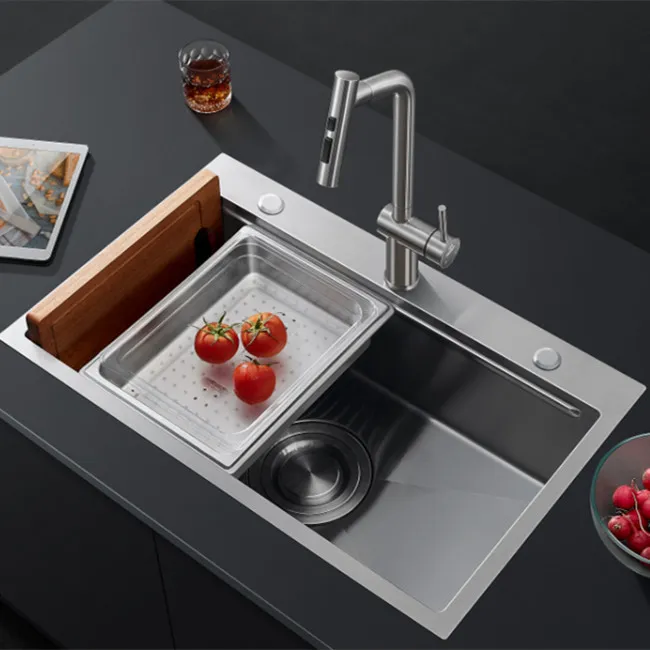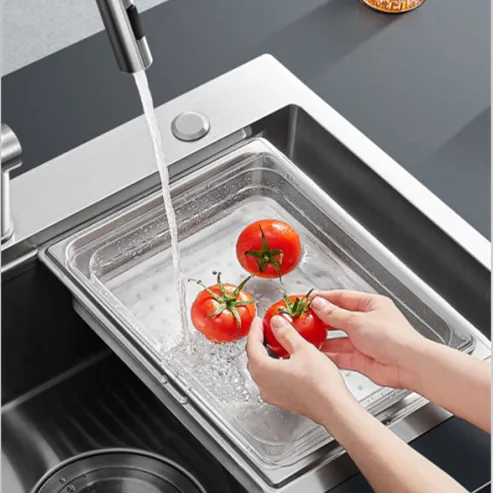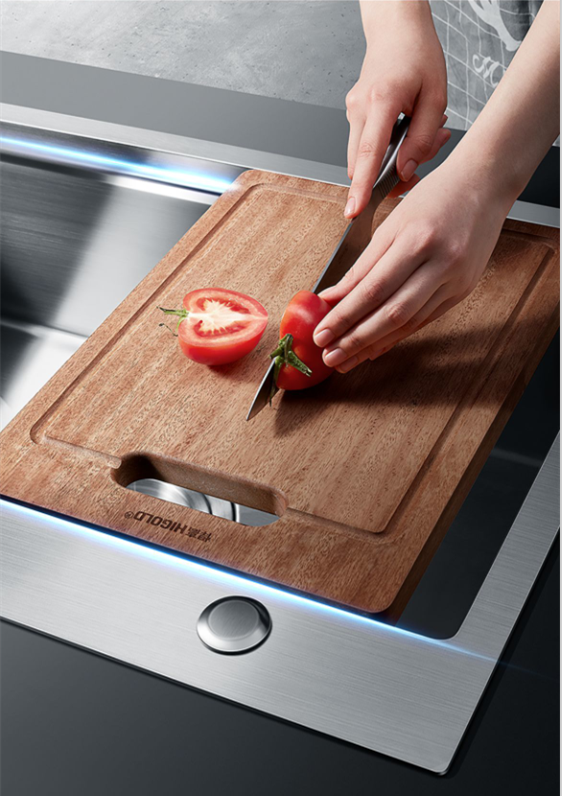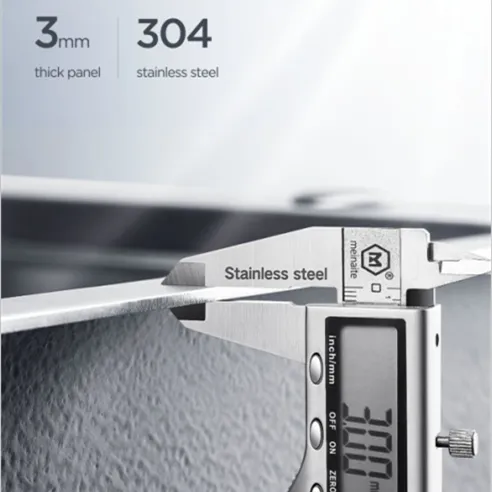Stainless steel kitchen sinks are a popular choice for their durability, ease of cleaning, and corrosion resistance. However, many consumers find that their once-sparkling stainless steel sinks gradually become dull, even taking on a grayish, lusterless appearance. This phenomenon often leaves users perplexed: Stainless steel is known for its corrosion resistance and brilliance, so why is their sink so dull?
With this question in mind, this article systematically examines the causes of dull stainless steel kitchen sinks, comprehensively analyzing the issue from material properties, cleaning habits, usage environment, and maintenance methods.

Stainless Steel Kitchen Sinks: The Root Cause of Dullness
To understand why stainless steel kitchen sinks become dull, it's important to first understand their material properties.
1. Stainless Steel Surface Structure
Stainless steel kitchen sinks are typically made of high-quality stainless steel such as 304 or 316, with brushed, mirrored, or matte finishes. They possess a natural chromium oxide passivation film on the surface, which blocks moisture and air from reaching the metal, preventing oxidation and rust.
2. Dullness Doesn't Mean Rust
When a stainless steel kitchen sink appears dull, it doesn't necessarily mean the metal has rusted. In fact, dullness often indicates a loss of gloss due to damage to the surface's protective film or the accumulation of contaminants. Once the passive film is damaged, water stains, dirt, and chemicals can more easily adhere, making the surface appear gray or dull.
3. Dependency of Surface Gloss
The brightness of a stainless steel kitchen sink depends on the integrity of the passive film and regular maintenance. Any mechanical friction, chemical corrosion, or residue accumulation will reduce the gloss and cause the sink to appear dull.
Thus, the root cause of dullness in stainless steel kitchen sinks is damage or contamination to the surface's protective layer, not a loss of the stainless steel's inherent properties.

Stainless Steel Kitchen Sinks: Cleaning Methods Are the Main Factor in Dulling
Surveys show that the most common cause of dullness in stainless steel kitchen sinks is closely related to cleaning methods, particularly the use of chemicals and excessively abrasive cleaning techniques.
1. Cleaners containing chlorine bleach
Bleach is a highly oxidizing chemical. If used directly on stainless steel kitchen sinks, it will damage the chromium oxide passive film on the surface, causing the originally shiny metal to lose its luster and appear dull.
2. Scrub pads soaked in bleach
Some households habitually use scouring pads pre-soaked with bleach to scrub sinks. This practice can also damage the passive film on the surface. Even a few minutes of contact can cause localized dulling, affecting the overall appearance.
3. Using a combination of fine steel wool and chemical cleaners
The most serious problem is scrubbing a stainless steel kitchen sink with fine steel wool pre-packed with detergent and bleach. The mechanical friction of the steel wool can scratch the surface, while the chemical attack of the bleach further damages the passive film, causing the sink's surface to lose its luster and appear mottled and dull.
From the above analysis, it can be seen that improper cleaning methods are the core factor leading to the dulling of stainless steel kitchen sinks.

Stainless Steel Kitchen Sinks: Impact of Usage Environment and Daily Operation
In addition to cleaning methods, the environment and operating habits of a stainless steel kitchen sink can also affect its surface gloss.
1. Water Quality
• Water in hard water areas contains high levels of minerals. Evaporating water droplets can leave white stains on the surface of a stainless steel kitchen sink. Over time, these stains can cause the sink to appear dull.
• Water with high chlorine or salt content can accelerate the breakdown of the passive film, causing the surface to lose its gloss.
2. Long-Term Residue
• Food residue, oil, juice, or seasonings left on the surface of a stainless steel kitchen sink for extended periods can also cause localized dulling.
• Prolonged contact of certain acidic ingredients (such as lemon juice and vinegar) with the sink surface can corrode the passive film, forming dark spots.
3. Mechanical Abrasion
• Direct friction between sharp knives and metal pots and pans and the sink bottom can leave microscopic scratches. Accumulated scratches can affect the gloss.
• Using steel wool or rough scouring pads to clean the sink can also cause mechanical damage, causing the stainless steel kitchen sink to appear dull.
In summary, improper daily handling and harsh operating environments can accelerate the dulling of a stainless steel kitchen sink.
How to restore the shine of a stainless steel kitchen sink?
Don't panic when faced with a dull sink; scientific polishing and maintenance methods can restore its brilliant luster.
1. Choose the right polishing tools
• A soft sponge, microfiber cloth, or a dedicated stainless steel polishing cloth is preferred.
• Avoid steel wool or rough scouring pads to prevent secondary scratches.
2. Use a mild polishing agent
• A neutral, chlorine-free, dedicated stainless steel polishing agent is recommended.
• For minor dulling, polish with a small amount of toothpaste or a paste made of baking soda and water.
3. Polish along the surface grain
• Brushed stainless steel kitchen sinks should be polished gently along the original grain to avoid cross-grain scratches.
• Mirror-finish sinks can be polished in small circular motions to achieve an even gloss.
4. Rinse and Dry
• After polishing, rinse thoroughly with clean water to ensure all polish residue is removed.
• Finally, wipe the sink surface dry with a dry cloth to prevent water stains from re-tarnishing.
Proper polishing can effectively restore the luster of a stainless steel kitchen sink and extend its lifespan.

Daily Measures to Prevent Tarnishing of Stainless Steel Kitchen Sinks
In addition to polishing, preventing tarnishing is equally important. Here are some HIGOLD recommendations:
1. Avoid Using Chlorine-Containing Cleaners
• Use a neutral detergent to clean stainless steel kitchen sinks whenever possible.
• Avoid direct contact of bleach or chlorine-containing cleaners with the sink surface.
2. Avoid Using Steel Wool
• Do not scrub the sink with steel wool or steel wool containing chemical cleaners.
• For stubborn stains, use a soft brush or sponge for gentle scrubbing.
3. Promptly Clean Up Debris and Water Droplets
• Rinse the sink immediately after use and dry with a dry cloth.
• Avoid prolonged contact of acidic or alkaline ingredients with the sink surface.
4. Regular Maintenance and Light Polishing
• For frequently used sinks, light polishing can be performed every 3 to 6 months to maintain the surface's brightness.
• For less frequently used sinks, the polishing interval can be extended.
5. Improve Water Quality
• If the water is hard, install a water softener or use a water filter to reduce mineral deposits.
Common Consumer Misconceptions
1. Assuming a dull appearance indicates rust
Many people mistakenly believe a dull sink indicates rust. In fact, most cases of dullness are caused by a damaged passive film or water stains, not metal corrosion.
2. Frequent Use of Chemical Cleaners
Some consumers believe that strong cleaners can keep sinks clean. However, chemicals containing chlorine or strong acidity or alkalinity can damage the passive film and have the opposite effect.
3. Neglecting Polishing and Maintenance
Many users believe that stainless steel sinks require no maintenance. In fact, regular polishing and light maintenance can extend the life of a sink and maintain its brightness.
Why is my stainless steel kitchen sink so dull?
The answer lies in a damaged or contaminated surface protective film. Core culprits include using cleaners containing chlorine bleach, bleach-soaked scouring pads, and, in the worst case, scrubbing with fine steel wool pre-loaded with detergent and bleach. Additionally, factors such as water quality, debris accumulation, and mechanical friction can accelerate surface dulling.
What future direction is Higold focusing on?
While Higold already leads the industry with automation and innovation, we continue to develop new materials and intelligent kitchen system solutions. Buyers can expect more aesthetically pleasing, practical, and high-quality sinks. Wholesale distributors, retailers, and purchasing managers can request quotes, secure promotions, and buy directly from our factory at competitive prices.


